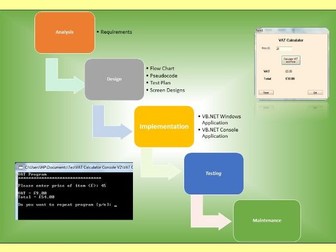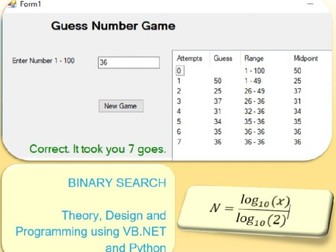VAT calculator program in VB.NET - Analysis,Design, Implementation, Testing
A complete life cycle approach i.e. Analysis, Design , Implementation and Testing for a simple VAT calculator program using VB.NET (Windows and Console Applications).<br />
<br />
Ideally this can be used on a Level 2 /Level 3 course such as GCSE/A Level Computing, BTEC Computing/ICT courses. Intended target audience age range is 14-19. Could also be used for mature learners who are new to programming or even younger learners. Handout can be given to learners who can then work independently. They may need some assistance with implementation if this is the first time they are using VB.NET.<br />
<br />
Implementation:<br />
<br />
The implementation is done in Visual Basic NET using Microsoft Visual Studio 2013 and there are two implementations (Windows and Console applications). The implementation is not a complete step by step guide showing how to create the program but full code listing is provided as well as the Microsoft Visual Studio VB.NET projects. <br />
<br />
Implementation demonstrates the following techniques:<br />
Sequencing , Iteration (console application), FormatCurrency function, CDec function , Exception handling. <br />
<br />
Implementation can cover approximately 2 lessons (one lesson for creating a Windows Application and one for console application). <br />
<br />
Designs:<br />
<br />
Designs include: Flow chart, pseudocode, Test Plan, Input -Process-Output Table, Screen Designs<br />
<br />
Files included:<br />
Word document showing detailed designs, testing and implementation.<br />
VB.NET Solutions ( Windows application and Console application)


